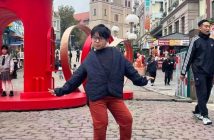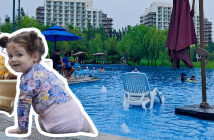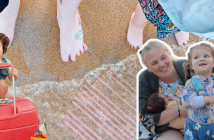
For the Dragon Boat Festival holiday we tagged along on for what turned out to be a frenzied, but fun, multi-family trip to Beidaihe organized by a group of parents who are members of the Beijing Running Club.
With our one toddler, we certainly had it easy by comparison – two of the families had twins and one of them came with five kids in tow.
Figuring out transportation was probably the most challenging part – half of the group went by train while the other half drove. Buying train tickets to Beidaihe was not a problem (we took the D11 Beijing-Shenyang North train from Beijing Railway Station on Monday afternoon at 1.55pm and arrived at 3.45pm – RMB 86 for adults, RMB 43 for kids, plus RMB 15 agency fee), but due to heavy holiday demand it took a few days of heroic phone calling and e-mailing back and forth by a few group members before we finally secured tickets back to Beijing for Wednesday (the 10.18am-3.18pm slow train T5684, originating from Qinghuangdao, to Beijing West – RMB 97 adults, RMB 47 kids, plus RMB 15 agency fee).
 We left with a smaller sub-group comprised of five adults and three toddlers Monday afternoon. Getting everyone on board the 1.55pm train was the first challenge – fortunately one of our party had the experience and foresight to hire a red-capped porter who helped cart our luggage (at the rate of RMB 10 per adult) from the waiting area on to the platform through a lesser-known back entrance – a smart move given the crowds and humidity.
We left with a smaller sub-group comprised of five adults and three toddlers Monday afternoon. Getting everyone on board the 1.55pm train was the first challenge – fortunately one of our party had the experience and foresight to hire a red-capped porter who helped cart our luggage (at the rate of RMB 10 per adult) from the waiting area on to the platform through a lesser-known back entrance – a smart move given the crowds and humidity.
Once we arrived at the Beidaihe train station, getting to our hotel was the next big test. Cabs are plentiful outside the station, but prepare to haggle – fares are not regulated like they are for cabs coming out of the Beijing airports and drivers will frequently jack up the prices for tourists.

We finally settled on RMB 40 per cab (only to find out later that others paid RMB 30) for three taxis to take us to our hotel, the Guest House for Diplomatic Missions (外交人员北戴河宾馆, 1 Baosanlu, BJ office 6532 4336, BDH 0335-4280999), situated in a picturesque compound overlooking Zhonghaitian Beach. The 34-villa guesthouse dates back to the 1950s, when Zhou Enlai approved it as residence for foreign guests and dignitaries.
The rooms here are comfortable and well-kept, and equipped with spacious balconies and decent bathrooms (we paid RMB 400 a night for a double room with separate twin and full-sized beds. Correction and Note: This price was based on a special group discount negotiated by our group organizers. Prices typically range from between RMB 980-1,280 — although some bargaining is possible — and the hotel says it is currently fully booked until late August). Multiple guesthouses are scattered throughout the hotel grounds and there are a couple of dining halls (serving Western-cum-Chinese buffets – RMB 40 per adult for lunch and dinner, RMB 20 breakfast, kids under 1.3m are half price), an outdoor beer garden, tennis courts, fitness center, pool hall, bowling alley, a playground and a bar.
Another perk of staying at the Diplomatic Guesthouse is access to its own private beach, which is a mere minute’s walk from the compound’s southern entrance. Hotel guests are issued swimming passes that allows access to a decently-sized swathe of sand, changing rooms and a small grill serving barbecue and snacks.
Perhaps the most striking thing to us about Beidaihe during the whole trip was the heavy presence of Russian tourists – so much so that the entire city seems to be reconstructing itself into a Russian seaside resort complete with Cyrillic signage and Eastern Bloc architecture. The buffet meals at the hotel were heavy on Russian items (i.e. borscht and pork shashlik) and virtually every other foreign guest outside of our party was Russian-speaking.

A quick two-minute walk up Baosan Lu along the waterfront takes you to a reconstructed town center that literally looks like it was transported from any number of small Eastern European cities. Here you’ll find a range of seafood restaurants, hostels, hotels, souvenir shops, convenience stores and a bank.
For lunch and dinner on our second day we ventured out to this part of town for some seafood. The shellfish, crab and fish we had were indeed fresh and well-made, but as is the case with many tourist spots in the country, price gouging and other unscrupulous business practices are rampant – both restaurants we visited attempted to slip us bills with jacked up prices.

At the first restaurant (the name of which, unfortunately, escapes me) we had a lunch consisting of some shellfish, a crab, a flounder and some dumplings for two adults and our small child that cost an alarming RMB 356 (based on “seasonal prices”), and we faced the same problem again after dinner that night at a different restaurant (Bohai Restaurant), where our much larger group was given a bill amounting to almost RMB 3,000, with seven plates of seafood dumplings costing RMB 540. Fortunately the eagle-eyed among us managed to spot this on the bill and they sheepishly recalculated a much more reasonable price (with the waitstaff imploring us not to make a scene, implying that this is a common practice).

Price gouging and “Disneyfied” architecture aside, the reinvention of Beidaihe is not entirely a bad thing – the local economy appears to be booming and we were impressed by the beaches despite the too-cold-to-swim-in water (the weather was overcast and unseasonably cool during our stay). Beidaihe is certainly not Phuket, or, perhaps, even Qingdao, but it is an entirely pleasant and relatively accessible summertime getaway from the Big City.
We’re now looking forward to checking out the purportedly less crowded beaches of nearby Nandaihe.



